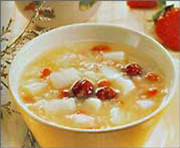As is known to all, Chinese food enjoys a high reputation in the world. Due to the diversity of the climate, products and customs, there is a wide range of different food styles and tastes based on regions.
In prepared dishes, the stronger fragrant aroma stimulates one's appetite. With the use of scallion, fresh ginger, root garlic or chili pepper; wine, aniseed, cinnamon, peppercorn or sesame oil, complementary nuances are added. Soy sauce, sugar, vinegar and other seasonings may be also used discreetly, adding more to the taste. Chinese dishes strive for harmony of sight, smell, taste, texture, so that each individual dish has its unique features.
Shandong Cuisine
Consisting of Jinan cuisine and Jiaodong cuisine, Shandong cuisine, clean, pure and not greasy, is characterized by its emphasis on aroma, freshness, crispness and tenderness. Shallots and garlic are frequently used so Shandong dishes taste pungent. Soups are paid much attention as well. Thin soups are clear and fresh while creamy soups are thick and taste strong. Jinan chefs are adept at deep-frying, grilling, pan-frying and stir-frying while Jiaodong chefs are famous for cooking seafood with a fresh and light taste.
Sichuan Cuisine
Sichuan Cuisine, commonly known in the West as Szechuan Cuisine, is one of the most famous Chinese cuisines in the world. Characterized by its spicy and pungent flavors, Sichuan cuisine, with a myriad of tastes, emphasizes the use of chili. Pepper and prickly ash are always in accompaniment, producing the typical exciting tastes. Garlic, ginger and fermented soybean are also used in the cooking process. Wild vegetables and meats such as are often chosen as ingredients, while frying, frying without oil, pickling and braising are used as basic cooking techniques.It can be said that one who doesn't experience Sichuan food has never reached China.
Guangdong Cuisine (Cantonese Cuisine)
Tasting clean, light, crisp and fresh, Guangdong cuisine, familiar to Westerners, usually has fowl and other meats that produce its unique dishes. The basic cooking techniques include roasting, stir-frying, sauteing, deep-frying, braising, stewing and steaming. Steaming and stir-frying are most frequently used to preserve the ingredients' natural flavors. Guangdong chefs also pay much attention to the artistic presentation of their dishes.
Fujian Cuisine
Combining Fuzhou Cuisine, Quanzhou Cuisine and Xiamen Cuisine, Fujian Cuisine is renowned for its choice seafood, beautiful color and magical tastes of sweet, sour, salt and savory. The most distinct feature is their "pickled taste".
Jiangsu Cuisine
Jiangsu Cuisine, also called Huaiyang Cuisine, is popular in the lower reaches of the Yangtze River. Using fish and crustaceans as the main ingredients, it stresses their freshness. Its carving techniques are delicate, of which the melon carving technique is especially well known. Cooking techniques consist of stewing, braising, roasting, and simmering. The flavor of Huaiyang Cuisine is light, fresh and sweet and its presentation is delicately elegant.
Zhejiang Cuisine
Comprising local cuisines of Hanzhou, Ningbo, and Shaoxing, Zhejiang Cuisine is not greasy. It wins its reputation for freshness, tenderness, softness, and smoothness of its dishes with their mellow fragrance. Hangzhou Cuisine is the most famous one of the three.
Hunan Cuisine
Hunan cuisine consists of local cuisines of Xiangjiang Region, Dongting Lake and Xiangxi coteau areas. It is characterized by thick and pungent flavors. Chili, pepper and shallot are usually necessities in this variation.
Anhui Cuisine
Anhui Cuisine chefs focus much more attention on the temperature in cooking and are good at braising and stewing. Often ham will be added to improve taste and candied sugar added to gain freshness.








 more
more


 more
more



 print
print  email
email  Favorite
Favorite  Transtlate
Transtlate 
